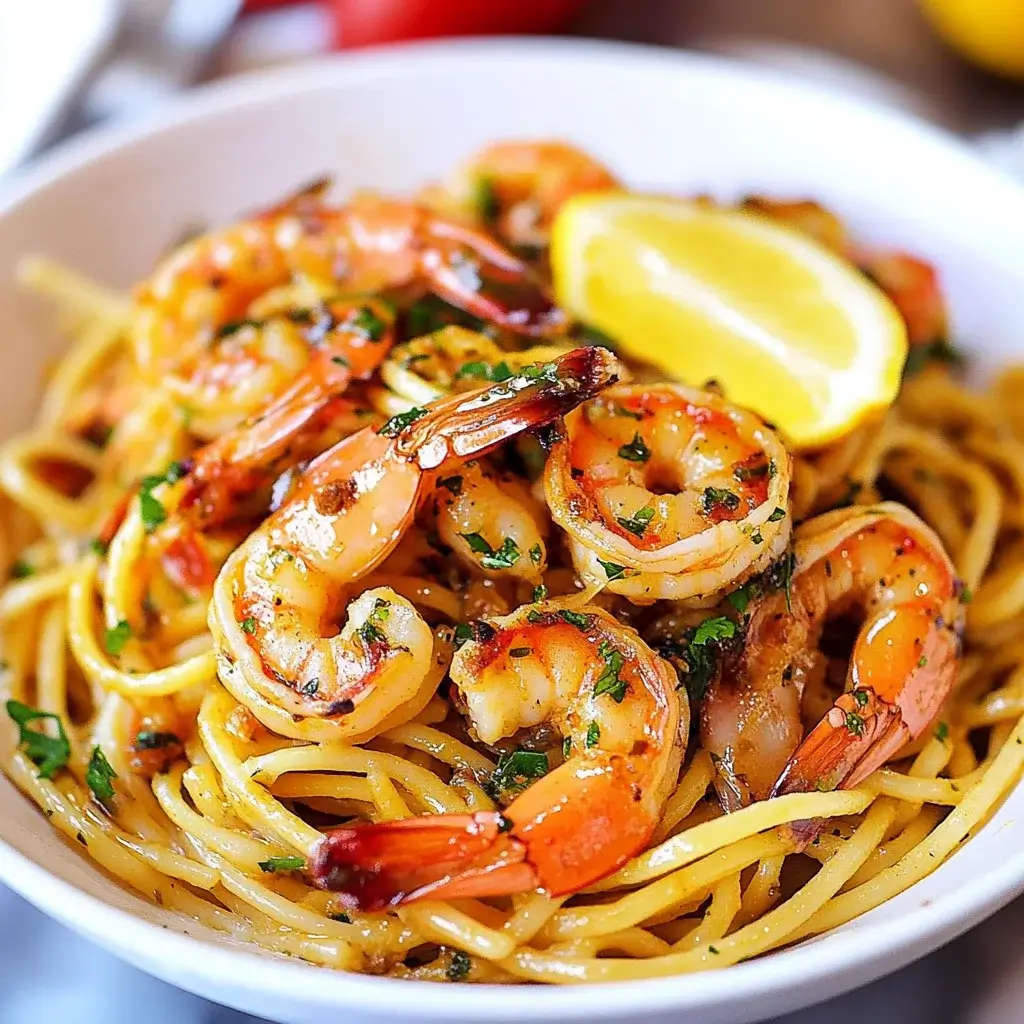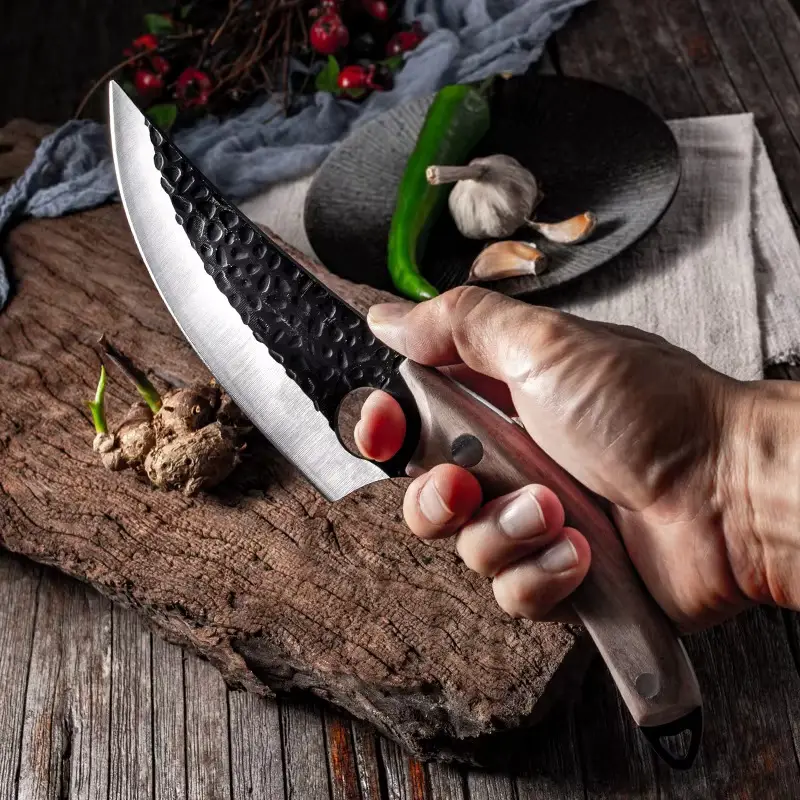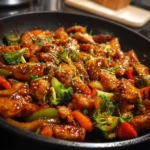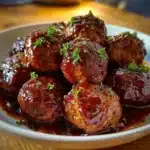Let me tell you, weeknight dinners at my house can sometimes feel like a culinary tightrope walk. Balancing speed, ease, and something that actually excites everyone at the table? It’s a challenge! That’s why discovering Garlic Butter Shrimp Pasta felt like striking gold. From the first sizzling sound of garlic in butter to the slurping satisfaction echoing around the table, this dish has become a true family favorite. Even my pickiest eater, who usually approaches seafood with suspicion, devours it with gusto. There’s just something undeniably comforting and luxurious about the buttery, garlicky sauce clinging to perfectly cooked pasta and tender shrimp. It’s become our go-to for busy evenings when we crave something special without spending hours in the kitchen. Honestly, if you’re looking for a recipe that’s guaranteed to please and become a staple in your own home, look no further. This Garlic Butter Shrimp Pasta is it – simple ingredients, incredible flavor, and ready in a flash. Prepare to be amazed by how such humble components can create such a restaurant-worthy dish right in your own kitchen!
Ingredients
- 1 pound Shrimp: Peeled and deveined, ensuring quick cooking and ease of eating. Medium to large shrimp work best for a satisfying bite.
- 1 pound Pasta: Linguine, spaghetti, or fettuccine are classic choices that beautifully hold the sauce. You can also use penne or rotini if preferred.
- ½ cup (1 stick) Unsalted Butter: Provides richness and flavor as the base of the delicious sauce. Using unsalted butter allows you to control the overall saltiness of the dish.
- 6 cloves Garlic: Minced finely to infuse the butter with a pungent and aromatic garlic flavor. Fresh garlic is essential for the best taste.
- ½ cup Dry White Wine (Optional): Adds depth and acidity to the sauce, deglazing the pan and creating a more complex flavor profile. Use a dry variety like Pinot Grigio or Sauvignon Blanc. You can substitute with chicken broth if you prefer to omit the wine.
- ¼ teaspoon Red Pepper Flakes: Lends a subtle warmth and a touch of spice to balance the richness of the butter. Adjust to your spice preference or omit entirely if you prefer a milder dish.
- ½ cup Fresh Parsley: Chopped, brightens the dish with a fresh, herbaceous note and adds a pop of color. Flat-leaf parsley is recommended for its robust flavor.
- 2 tablespoons Lemon Juice: Freshly squeezed, provides acidity and brightness, cutting through the richness of the butter and enhancing the flavors of the shrimp and garlic.
- Salt: To taste, essential for seasoning both the pasta water and the sauce, enhancing all the flavors.
- Black Pepper: Freshly ground, to taste, adds a final layer of flavor and a subtle bite.
- 2 tablespoons Olive Oil: Used for sautéing the shrimp, preventing sticking and adding a healthy fat to the dish. Extra virgin olive oil is a good choice for its flavor.
Instructions
- Cook the Pasta: Bring a large pot of salted water to a rolling boil. Add the pasta and cook according to package directions until al dente. “Al dente” means “to the tooth” in Italian, indicating pasta that is cooked through but still firm to the bite. Drain the pasta, reserving about ½ cup of the pasta water. The starchy pasta water will help create a silky sauce.
- Sauté the Shrimp: While the pasta is cooking, heat the olive oil in a large skillet over medium-high heat. Ensure the skillet is large enough to accommodate all the shrimp in a single layer to promote even cooking. Add the shrimp to the hot skillet and cook for 2-3 minutes per side, or until they are pink and opaque and cooked through. Be careful not to overcook the shrimp, as they can become rubbery. Remove the cooked shrimp from the skillet and set aside.
- Make the Garlic Butter Sauce: Reduce the heat to medium. Add the butter to the same skillet and let it melt completely. Once melted, add the minced garlic and red pepper flakes (if using). Sauté the garlic for about 1 minute, or until fragrant and lightly golden, being careful not to burn it. Burnt garlic will taste bitter.
- Deglaze the Pan (Optional but Recommended): If using white wine, pour it into the skillet. Increase the heat to medium-high and bring the wine to a simmer, scraping up any browned bits from the bottom of the pan. This process, called deglazing, adds depth of flavor to the sauce. Let the wine reduce slightly for about 1-2 minutes. If you are not using wine, you can skip this step and proceed to the next.
- Combine Sauce and Pasta Water: Pour the reserved pasta water into the skillet with the garlic butter sauce. The starch in the pasta water will help emulsify the sauce and give it a creamy texture. Stir to combine everything.
- Add Shrimp and Pasta: Add the cooked shrimp back to the skillet with the sauce. Toss gently to coat the shrimp in the garlic butter sauce. Add the drained pasta to the skillet as well. Toss everything together until the pasta is well coated in the sauce and the shrimp is evenly distributed.
- Finish and Season: Stir in the chopped fresh parsley and lemon juice. Season with salt and freshly ground black pepper to taste. Start with a pinch of salt and pepper and adjust according to your preference. Taste and adjust seasonings as needed.
- Serve Immediately: Serve the Garlic Butter Shrimp Pasta immediately while it’s hot and flavorful. Garnish with extra fresh parsley and a lemon wedge if desired.
Nutrition Facts
(Approximate values per serving, based on 4 servings. Nutritional values can vary based on specific ingredients and portion sizes.)
- Serving Size: Approximately 1.5 cups
- Calories: Approximately 550-650 kcal per serving. Calories can vary based on the type of pasta and amount of butter used. This dish provides a satisfying and moderately calorie-dense meal, suitable for a balanced diet when consumed in moderation.
- Protein: Approximately 30-40 grams per serving. Shrimp is an excellent source of lean protein, essential for muscle building and repair, as well as overall satiety. Protein contributes to feeling full and satisfied after a meal.
- Fat: Approximately 25-35 grams per serving. This includes both healthy fats from olive oil and butter. While butter is a source of saturated fat, when consumed in moderation as part of a balanced diet, it contributes to flavor and richness. The olive oil provides monounsaturated fats, which are considered heart-healthy.
Note: These are estimated values and can fluctuate. For precise nutritional information, use a nutrition calculator with the specific brands and quantities of ingredients you use.
Preparation Time
- Prep Time: 15 minutes. This includes peeling and deveining shrimp, mincing garlic, chopping parsley, and measuring ingredients. The quick prep time makes this recipe ideal for busy weeknights.
- Cook Time: 20 minutes. This includes cooking the pasta, sautéing the shrimp, and making the sauce. The short cooking time ensures a fast and satisfying meal.
- Total Time: 35 minutes. From start to finish, this Garlic Butter Shrimp Pasta can be on your table in just over half an hour, making it a perfect choice for a quick and delicious dinner.
How to Serve
Garlic Butter Shrimp Pasta is delicious on its own, but here are some serving suggestions to make it a complete and satisfying meal:
- Classic Pairings:
- Garlic Bread: Serve with crusty garlic bread or toasted baguette slices for dipping into the flavorful sauce.
- Side Salad: A simple green salad with a light vinaigrette provides a refreshing contrast to the richness of the pasta. Consider a Caesar salad, a mixed green salad, or a Caprese salad.
- Vegetable Sides:
- Roasted Asparagus: Roasting asparagus brings out its natural sweetness and provides a healthy and vibrant side dish.
- Steamed Broccoli: Steamed broccoli florets offer a simple and nutritious vegetable accompaniment.
- Sautéed Spinach: Sautéed spinach with garlic and olive oil is a quick and easy way to add greens to your meal.
- Garnishes to Enhance:
- Freshly Grated Parmesan Cheese: Sprinkle freshly grated Parmesan cheese over the pasta just before serving for a salty and savory finish.
- Extra Fresh Parsley: Garnish with additional chopped fresh parsley for a pop of color and fresh flavor.
- Lemon Wedges: Serve with lemon wedges on the side, allowing guests to add an extra squeeze of lemon juice to brighten the dish to their liking.
- Red Pepper Flakes (for Spice Lovers): Offer extra red pepper flakes for those who enjoy a spicier kick.
Additional Tips for Perfect Garlic Butter Shrimp Pasta
- Don’t Overcook the Shrimp: Shrimp cooks quickly. Overcooked shrimp becomes rubbery and loses its delicate flavor. Cook just until pink and opaque.
- Use Fresh Garlic: Freshly minced garlic is crucial for the best flavor. Garlic powder is not a suitable substitute in this recipe.
- Reserve Pasta Water: Don’t forget to reserve pasta water! The starch in the pasta water is essential for creating a silky, emulsified sauce that clings beautifully to the pasta.
- Taste and Season as You Go: Season each layer of the dish. Salt the pasta water, season the shrimp lightly before cooking, and taste and adjust the seasoning of the sauce before adding the pasta.
- Adjust Spice Level: Control the heat by adjusting the amount of red pepper flakes. For a milder dish, omit them entirely. For extra spice, add a pinch more or use a pinch of cayenne pepper.
- Make it Creamier: For a creamier sauce, stir in a tablespoon or two of heavy cream or crème fraîche at the end. This will add extra richness and a velvety texture.
- Add Vegetables: Incorporate vegetables like cherry tomatoes, spinach, or artichoke hearts to add more nutrients and flavor. Sauté them with the garlic or add spinach towards the end of cooking.
- Upgrade Your Wine: If you’re using wine, a good quality dry white wine like Pinot Grigio, Sauvignon Blanc, or Chardonnay will enhance the flavor of the sauce. However, a simple dry white wine will still work well.
FAQ Section
Q1: Can I use frozen shrimp?
A: Yes, you can definitely use frozen shrimp. Make sure to thaw them completely before cooking. Pat them dry with paper towels to remove excess moisture for better browning and flavor.
Q2: What kind of pasta is best for this dish?
A: Linguine, spaghetti, and fettuccine are classic choices as their long strands are excellent for holding onto the sauce. However, you can also use penne, rotini, or any pasta shape you prefer.
Q3: I don’t have white wine. Can I still make this recipe?
A: Absolutely! You can substitute the white wine with chicken broth or vegetable broth. It will still create a delicious sauce, although the wine does add a layer of complexity.
Q4: How do I prevent the garlic from burning?
A: Garlic burns easily. Sauté it over medium heat and watch it closely. As soon as it becomes fragrant and lightly golden, it’s ready. Don’t let it turn brown or dark brown, as it will become bitter.
Q5: Can I make this dish ahead of time?
A: Garlic Butter Shrimp Pasta is best enjoyed fresh. Shrimp can become rubbery if reheated. If you need to prep ahead, you can cook the pasta and make the sauce separately, then combine them with freshly cooked shrimp just before serving.
Q6: Can I make this recipe gluten-free?
A: Yes, easily! Simply use your favorite gluten-free pasta. All the other ingredients are naturally gluten-free. Ensure your broth (if using) is also certified gluten-free.
Q7: How do I store leftovers?
A: Store leftover Garlic Butter Shrimp Pasta in an airtight container in the refrigerator for up to 2 days. Reheat gently in a skillet over low heat or in the microwave, adding a splash of water or broth if needed to loosen the sauce. Be mindful that the shrimp may become slightly less tender upon reheating.
Q8: Can I add cheese to this pasta?
A: While Parmesan cheese is often served as a garnish, adding cheese directly to the sauce is not traditional for this recipe. However, if you enjoy cheesy pasta, you can experiment with adding a small amount of grated Parmesan or Pecorino Romano cheese to the sauce towards the end of cooking for a richer, cheesier flavor. Just be mindful of the salt content when adding cheese.

Garlic Butter Shrimp Pasta
Ingredients
- 1 pound Shrimp: Peeled and deveined, ensuring quick cooking and ease of eating. Medium to large shrimp work best for a satisfying bite.
- 1 pound Pasta: Linguine, spaghetti, or fettuccine are classic choices that beautifully hold the sauce. You can also use penne or rotini if preferred.
- ½ cup (1 stick) Unsalted Butter: Provides richness and flavor as the base of the delicious sauce. Using unsalted butter allows you to control the overall saltiness of the dish.
- 6 cloves Garlic: Minced finely to infuse the butter with a pungent and aromatic garlic flavor. Fresh garlic is essential for the best taste.
- ½ cup Dry White Wine (Optional): Adds depth and acidity to the sauce, deglazing the pan and creating a more complex flavor profile. Use a dry variety like Pinot Grigio or Sauvignon Blanc. You can substitute with chicken broth if you prefer to omit the wine.
- ¼ teaspoon Red Pepper Flakes: Lends a subtle warmth and a touch of spice to balance the richness of the butter. Adjust to your spice preference or omit entirely if you prefer a milder dish.
- ½ cup Fresh Parsley: Chopped, brightens the dish with a fresh, herbaceous note and adds a pop of color. Flat-leaf parsley is recommended for its robust flavor.
- 2 tablespoons Lemon Juice: Freshly squeezed, provides acidity and brightness, cutting through the richness of the butter and enhancing the flavors of the shrimp and garlic.
- Salt: To taste, essential for seasoning both the pasta water and the sauce, enhancing all the flavors.
- Black Pepper: Freshly ground, to taste, adds a final layer of flavor and a subtle bite.
- 2 tablespoons Olive Oil: Used for sautéing the shrimp, preventing sticking and adding a healthy fat to the dish. Extra virgin olive oil is a good choice for its flavor.
Instructions
- Cook the Pasta: Bring a large pot of salted water to a rolling boil. Add the pasta and cook according to package directions until al dente. “Al dente” means “to the tooth” in Italian, indicating pasta that is cooked through but still firm to the bite. Drain the pasta, reserving about ½ cup of the pasta water. The starchy pasta water will help create a silky sauce.
- Sauté the Shrimp: While the pasta is cooking, heat the olive oil in a large skillet over medium-high heat. Ensure the skillet is large enough to accommodate all the shrimp in a single layer to promote even cooking. Add the shrimp to the hot skillet and cook for 2-3 minutes per side, or until they are pink and opaque and cooked through. Be careful not to overcook the shrimp, as they can become rubbery. Remove the cooked shrimp from the skillet and set aside.
- Make the Garlic Butter Sauce: Reduce the heat to medium. Add the butter to the same skillet and let it melt completely. Once melted, add the minced garlic and red pepper flakes (if using). Sauté the garlic for about 1 minute, or until fragrant and lightly golden, being careful not to burn it. Burnt garlic will taste bitter.
- Deglaze the Pan (Optional but Recommended): If using white wine, pour it into the skillet. Increase the heat to medium-high and bring the wine to a simmer, scraping up any browned bits from the bottom of the pan. This process, called deglazing, adds depth of flavor to the sauce. Let the wine reduce slightly for about 1-2 minutes. If you are not using wine, you can skip this step and proceed to the next.
- Combine Sauce and Pasta Water: Pour the reserved pasta water into the skillet with the garlic butter sauce. The starch in the pasta water will help emulsify the sauce and give it a creamy texture. Stir to combine everything.
- Add Shrimp and Pasta: Add the cooked shrimp back to the skillet with the sauce. Toss gently to coat the shrimp in the garlic butter sauce. Add the drained pasta to the skillet as well. Toss everything together until the pasta is well coated in the sauce and the shrimp is evenly distributed.
- Finish and Season: Stir in the chopped fresh parsley and lemon juice. Season with salt and freshly ground black pepper to taste. Start with a pinch of salt and pepper and adjust according to your preference. Taste and adjust seasonings as needed.
- Serve Immediately: Serve the Garlic Butter Shrimp Pasta immediately while it’s hot and flavorful. Garnish with extra fresh parsley and a lemon wedge if desired.
Nutrition
- Serving Size: one normal portion
- Calories: 650
- Fat: 35 grams
- Protein: 40 grams






